Compiled by Geoff Goodall
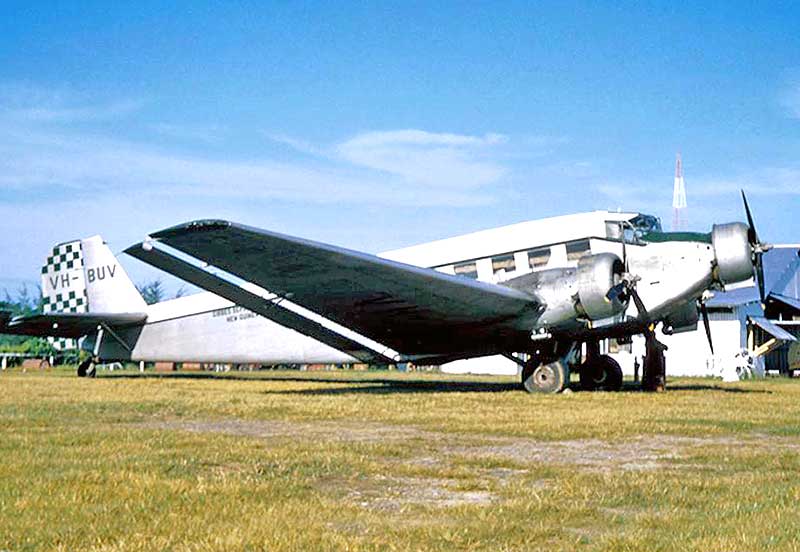
It has been re-engined with RAAF CAC Wirraway P&W R-1340 Wasp power plants with 3 bladed propellers.
Photo by Brian Horsey via Ron Cuskelly collection
Ju 52/3m trimotors were extensively flown as civil airliners by Lufthansa and many other European airlines, also in South America.
Total production was 4,845 aircraft, including Ju 52/3m variants built in Spain as CASA 352 and France as Amiot AAC.1 Toucan
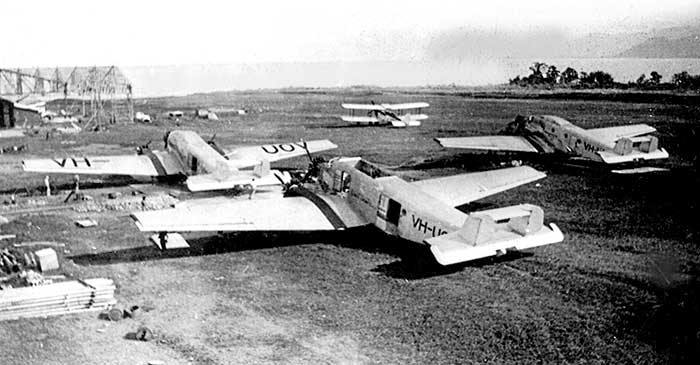
by Guinea Airways 1931-1941 and set world air freight records. Note the open roof hatch to load bulky cargo.
Photo at Lae by Guinea Airways G.31 pilot Bert Heath, courtesy Ben Dannecker collection
By 1954 Gibbes Sepik Airways at Goroka desperately needed larger capacity aircraft to handle the amount of air freight being offered. Founder Bobby Gibbes wanted to supplement his fleet of Noorduyn Norseman freighters with DC-3 size transports, but lacked the financial backing required. He was well aware of the remarkable feats carried out by the pre-war Guinea Airways Junkers G.31 trimotors and began to seriously consider that their replacement, the Ju 52/3m, would be a much cheaper compromise. However Gibbes' early enquiries brought the news that he was too late - the last of the civil Ju 52s in Europe had been retired and were gone.
Early 1955 Bobby Gibbes heard that a Swedish airline was advertising three Ju 52s for sale in "fly-away" condition, but at a high price. He travelled to Stockholm where he was disappointed to find them in a poor state, parked in the open winter weather with u/s engines and several engines missing. In his autobiography You Live But Once, Gibbes describes his frustrating negotiations that eventually brought the price down from £15,000 Sterling each to a more realistic £1,500 each, including a good stock of spare parts. Because of their neglected condition he intended to dismantle them for shipping to Australia, but the quoted sea freight costs were prohibitive. There was no choice but to overhaul each at Stockholm and fly them back. A Swedish engineer was employed to work on the best of the three, SE-BUE, while Gibbes chased up spare German BMW 132Z radial engines and parts.
His application to the Department of Civil Aviation for Australian registration of his veteran trimotors was met with little enthusiasm. As a new type, he had to satisfy DCA's strict airworthiness requirements which included a copy (in English) of the manufacturer's strength and stress design calculations plus all the aircraft manuals. Some of these he managed to provide, thanks to the help of British European Airways in London, which had operated 12 captured Luftwaffe Ju 52/3ms immediately after the end of the war.
Gibbes knew the aging BMW engines would be a continuing problem. He
decided that the 590hp BMWs could be replaced by 600hp P&W
R-1340 Wasps. He had earlier re-engined his Norseman fleet with the
Australian built R-1340-S1H1-G geared engine running 3 bladed Hamilton Standard
constant-speed propellers. This power plant was used by RAAF CAC
Wirraway trainers and Gibbes had purchased a number from RAAF
Disposals. He was determined to install them in his Ju 52s using
Wirraway engine cowlings. Because the engineering aspects were
complex, Marshall Airways at Sydney-Bankstown were contracted to
install the Wasps
and handle DCA certification of the modification.
DCA required a detailed stress analysis of the modified engine mounts and effects of the different engines before approving the modification drawings. Gibbes engaged Melbourne aviation engineering consultant M. Molyneaux to carry out this work, which extended to the strength of the wing structure and an analysis of the wartime German alloy used in the wing spar.
In June 1956 VH-BUU set off from Goroka for the ferry flight to Sydney, flown by GSA pilot John McDermott. The starboard BMW engine failed over Torres Strait and McDermott made a forced landing at Horn Island where they were stranded. Gibbes quickly arranged for a P&W R-1340-S1H1G to be flown from Sydney to Horn Island by wartime friend Brian Blackjack Walker, now chief test pilot for De Havilland Aircraft in Sydney. Walker delivered the dismantled power plant in a DHA-3 Drover, and despite minimum facilities at Horn Island, the u/s starboard BMW engine was removed and replaced by the nose BMW, and the P&W Wasp fitted in the nose position. McDermott continued the flight to Bankstown, where Sid Marshall's crew under chief engineer Jack Davidson and Eric Cross went to work replacing all engines. Sid himself knew the earlier Junkers G.31 trimotors well from his pre-war days as a ground engineer in New Guinea with Guinea Airways. In addition to the engine controls and fuel systems, the modifications included improved firewall sealing, flexible fuel lines replaced by fire-resistant materials, and installation of fire detection and extinguishing systems.
Brian Walker was also called on for the test flying, with Sid Marshall in the right hand seat for the early flights, followed by DCA performance trials with the lower-powered engines. The Department was satisfied and the CofA was amended to show the P&W engines. VH-BUU returned to New Guinea in September 1956 to commence freight work. Walker resigned from De Havilland Aircraft to join Bobby Gibbes as GSA Manager and Junkers pilot
Gibbes was so disenchanted with the BMW engines that he gained DCA approval for a field-modification to have the two Junkers at Stockholm re-engined with P&W Wasps prior to their delivery flights. GSA senior pilot Robin Gray had been sent to Sweden to supervise the preparation of the two aircraft, engaging experienced German engineer Paul Raasch, ex Lufthansa, to complete the overhauls then crew the delivery flights and remain with the airline in New Guinea. Two more engineers were employed, Eddie Halle from Germany and Swede Sten-Erik Molker. Six P&W Wasp power plants were shipped from Australia to Helsinki and installed - the removed BMW engines being sold in Europe to recoup some of the mounting costs.
Having experienced many radio problems on his Junkers ferry flight, Gibbes sent pilot Tony Chadim to Sweden to install modern Lear radio and navigation equipment to both aircraft, then crew the delivery flights to New Guinea.
DCA required a detailed stress analysis of the modified engine mounts and effects of the different engines before approving the modification drawings. Gibbes engaged Melbourne aviation engineering consultant M. Molyneaux to carry out this work, which extended to the strength of the wing structure and an analysis of the wartime German alloy used in the wing spar.
In June 1956 VH-BUU set off from Goroka for the ferry flight to Sydney, flown by GSA pilot John McDermott. The starboard BMW engine failed over Torres Strait and McDermott made a forced landing at Horn Island where they were stranded. Gibbes quickly arranged for a P&W R-1340-S1H1G to be flown from Sydney to Horn Island by wartime friend Brian Blackjack Walker, now chief test pilot for De Havilland Aircraft in Sydney. Walker delivered the dismantled power plant in a DHA-3 Drover, and despite minimum facilities at Horn Island, the u/s starboard BMW engine was removed and replaced by the nose BMW, and the P&W Wasp fitted in the nose position. McDermott continued the flight to Bankstown, where Sid Marshall's crew under chief engineer Jack Davidson and Eric Cross went to work replacing all engines. Sid himself knew the earlier Junkers G.31 trimotors well from his pre-war days as a ground engineer in New Guinea with Guinea Airways. In addition to the engine controls and fuel systems, the modifications included improved firewall sealing, flexible fuel lines replaced by fire-resistant materials, and installation of fire detection and extinguishing systems.
Brian Walker was also called on for the test flying, with Sid Marshall in the right hand seat for the early flights, followed by DCA performance trials with the lower-powered engines. The Department was satisfied and the CofA was amended to show the P&W engines. VH-BUU returned to New Guinea in September 1956 to commence freight work. Walker resigned from De Havilland Aircraft to join Bobby Gibbes as GSA Manager and Junkers pilot
Gibbes was so disenchanted with the BMW engines that he gained DCA approval for a field-modification to have the two Junkers at Stockholm re-engined with P&W Wasps prior to their delivery flights. GSA senior pilot Robin Gray had been sent to Sweden to supervise the preparation of the two aircraft, engaging experienced German engineer Paul Raasch, ex Lufthansa, to complete the overhauls then crew the delivery flights and remain with the airline in New Guinea. Two more engineers were employed, Eddie Halle from Germany and Swede Sten-Erik Molker. Six P&W Wasp power plants were shipped from Australia to Helsinki and installed - the removed BMW engines being sold in Europe to recoup some of the mounting costs.
Having experienced many radio problems on his Junkers ferry flight, Gibbes sent pilot Tony Chadim to Sweden to install modern Lear radio and navigation equipment to both aircraft, then crew the delivery flights to New Guinea.
They departed Sweden on 13 January 1957 on the VFR delivery flight to New Guinea in formation. On board were:
VH-BUV: Pilots Brian Blackjack Walker and Englishman John Green, engineers Paul Raasch and Eddie Halle, passengers Green's and Raasch's families, loaded with their household effects.
VH-BUW: Pilots Robin Gray and Tony Chadim, engineer Sten-Erik Molker, passengers Chadim's wife & daughter. Loaded with spare parts.
Previous owner Albin Ahrenberg accompanied them for the early stages across Europe.
They reached Goroka 26 days later to a great welcome as they circled the town in formation. They went to work as freighters. Despite the reduced power of the P&W Wasps, they quickly proved themselves worthy competition for the DC-3s of Qantas and Mandated Airlines. They were well-known across New Guinea and were referred to as "JUs". After the massive effort and expense of getting these other two Junkers to New Guinea, only days after going into service VH-BUW was wrecked in a takeoff accident on the notorious goldfields downhill sloping strip at Wau. Gibbes flew to Wau with his Junkers specialist engineer Paul Raasch, who said it could be repaired.
Such was Bobby Gibbes determination, a truck convoy and a team of drivers was contracted to move the dismantled aircraft down the mountains from Wau to Lae on a narrow winding road, then to Goroka, 300 miles. The rebuild in the airline maintenance hangar at Goroka was an aeronautical engineering triumph, taking 5 engineers a year to complete. It was achieved without manufacturer's drawings, equipment or jigs, using Americad Alcad to replace the wartime alloys, the properties of which were unknown. The skinning Alcad was in sheets, which had to be pressed into the corrugations that were an essential part of thge aircraft's design strength. DCA inspectors monitored the rebuild, their tests revealing that the tolerances achieved were better than those of the other two Junkers.
Some Gibbes Sepik pilot recollections sum up the Junkers period:
Ivan Bennett: "You didn't need a pilot's licence to fly the old JU, you needed a plumber's certificate. But it was a bloody good aeroplane. The corrugated metal construction made them very strong and gave them a much greater wing area than was apparent. They had great ability on short fields. I did a lot of air drops in the JU. You could get back to 65 knots which made the job easier. One of the worst I did was at Simbai, to drop a roller to Jim McKinnon who was building a strip there. We landed at Aiome to get the metal roller. Jim gave us a detailed plan to fly up the Simbai valley and drop the roller. All well in theory, but the Simbai valley did not have enough room to complete a 360 degree turn in the old JU. Coming around in the turn I could see we were in deep trouble, so just as we missed a ridge I gave the signal to drop the roller because I had to climb out of there. The roller went into the next valley and took 3 weeks to get it out."
Adrian Nisbet: "Those JUs were terrible things, heavy as a brick, but magnificent aircraft for the job. Imagine getting into the old Maprik strip only 1,600 feet long, with a trimotor carrying 7,500 pounds - as much as a DC-3. They were an extraordinary aircraft for their time. Qantas in New Guinea were stripping down their DC-3s to try to get a bit more payload out of them to compete with the Ju 52s."
They had several accidents, described in their individual histories below, but by the end of 1957 DCA had accepted the Ju 52s as part of New Guinea civil aviation operations. At this same time the Department was concerned by the inability of DC-3s to meet ICAO climb performance requirements after losing an engine on takeoff. Restrictions were imposed on the payload for New Guinea DC-3s, giving the Gibbes Sepik Airways Ju 52s a distinct advantage.
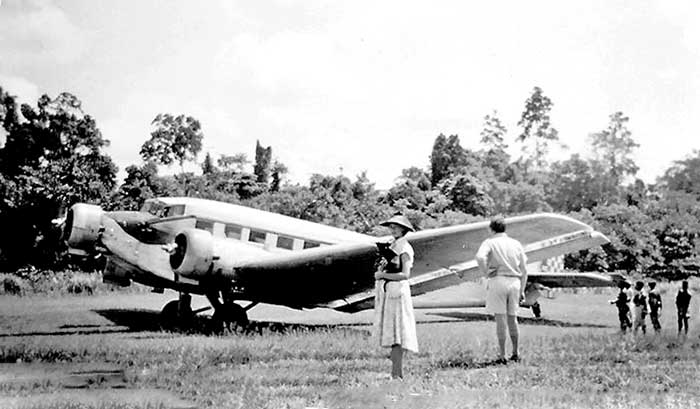
In March 1958 Gibbes applied to Australian Customs to import the pair, and import licences were issued. Senior pilot Robin Gray was sent to Africa the following month to organise delivery arrangements. A week after Gray had departed, Gibbes received a telegram stating that DCA Head Office had deferred a decision on his application for additional Junkers aircraft pending an Australian Federal Government Policy review into airline services in New Guinea - which was expected to commence in June 1958. Gibbes appealed to the Minister for Aviation in Canberra, who responded that the Customs import licences had been issued in error. Gibbes was beaten and recalled Gray from Africa before the purchase had been finalised.
Gibbes Sepik Airways continued to operate under its own name as part of the MAL organisation until April 1960. However MAL management was modernising its fleet and did not intend to keep the Junkers. VH-BUU was declared a write-off after being damaged in October 1959, despite engineers saying it could be repaired with spares stock inherited from GSA. The other two were retired the following year at Madang, left in the weather until sold for scrap metal.
| 41 | Built at Bamberg, Germany by Junkers Flugzeng Und Motorenwerke AG. Civil model Ju 52/3m-12 to the order of Deutsche Lufthansa. BMW 132L-2 radial engines. Not delivered to Lufthansa, leased new to Aero OY, Finland |
| 12.41 | Registered D-AVIU Deutsche Lufthansa. Allocated Lufthansa fleet name Theodor Schopwinkel |
| 6.12.41 | First flight Merseburg |
| 18.12.41 | Leased to Aero O/Y, Helsinki, Finland |
| 19.12.41 | Delivered Riga-Helsinki. Total airframe time: 5 hrs 15 mins |
| 27.12.41 | Entered passenger service Helsinki-Tallinn-Riga-Kaunas on behalf of Lufthansa |
| 19.2.42 | Registered OH-LAM Aero O/Y, Helsinki, Finland. Named Karjala |
| 42 | Used mainly on the Helsinki-Kaunas route until 12.42 |
| Re-engined with BMW 132Z radials | |
| 6.7.43 | Ground
collision when landing Helsinki-Malmi Airport from Turku, Captain
Laitinen: skidded off runway and struck a Finnish Air Force SB-2bis
which was wrecked. |
| 43 | OH-LAM repaired and returned to service |
| 4.49 | Retired by Aero, stored at Helsinki-Malmi |
| 8.11.51 | sold to Firma M. Ahrenberg, Stockholm, Sweden. BMW 132A engines |
| 30.4.52 | Delivered from Helsinki to Sweden |
| 4.52 | Registered SE-BUE Firma M. Ahrenberg trading as Aerotrafik, Stockholm-Bromma Airport, Sweden |
| 54 | Retired at Stockholm-Bromma Airport with two other Ahrenberg Ju 52s, parked in open awaiting sale |
| 4.55 | Inspected
at Stockholm, by R.H. Gibbes, founder of Gibbes Sepik Airways in New
Guinea. The three Junkers were advertised in good condition but on
arrival he found them in poor condition with some BMW engines removed.
Purchase negotiations began and Gibbes intended to send them as ship
cargo. |
| 4.55 | Purchased by Gibbes Sepik Airways, Goroka, New Guinea |
| Sea freight
cost proved prohibitive, so Gibbes engaged Swedish and German engineers
to overhaul the three Ju 52s at Stockholm to allow them to be delivered
by air to New Guinea. SE-BUE was considered to be best of the three, work concentrated on getting it airworthy, and locating serviced BMW engines to replace its worn engines. | |
| 28.9.55 | Registered VH-BUU Gibbes Sepik Airways, Goroka, New Guinea Registration date 6.10.55 recorded in the Civil Register Ledger at DCA Melbourne Head Office |
| 28.9.55 | One month provisional CofA issued by DCA to cover the delivery flight to New Guinea |
| 8.10.55 | Departed Stockholm on delivery flight to New Guinea. Captain R.H. Gibbes. pilot/engineer Gustav A. Jerdnell, passengers Gibbes' cousin Alison Moxham and her friend Jean Cameron. |
| 10.55 | Photo at Dusseldorf, Germany shows VH-BUU all metallic finish, with Gibbes Sepik Airways titles |
| Delayed several weeks at
Karachi waiting for a replacement crankshaft to be sent from Sweden and
installed in the port engine by Jerdnell | |
| Ferry continued via Delhi, Calcutta, Rangoon, Labuan, Zamboanga | |
| 18.11.55 | Arrived at Goroka |
| 1.12.55 | Test flown at Goroka by R. H. Gibbes after CofA inspection |
| 1.12.55 | Australian CofA issued by DCA |
| 12.55 | Entered freight service with Gibbes Sepik Airways |
| 6.56 | Departed Goroka on ferry
flight to Sydney, flown by GSA pilot John McDermott. Marshall Airways
at Sydney-Bankstown were contracted to replace the three BMW engines
with threeP&W R-1340-S1H1G Wasp geared power plants with 3-bladed Hamilton Standard 3D40 Constant-Speed propellers. |
| 6.56 | The
port BMW failed while
crossing Torres Strait, McDermott was unable to maintain altitude and
made a forced landing at Horn Island airfield. Stranded there with
assengers who had paid a special fare for the return trip to
Sydney. |
| Bobby Gibbes arranged for his wartime friend Brian R. Blackjack Walker, then chief test pilot for De Havilland Aircraft Pty Ltd at Bankstown, to bring a P&W R-1340 Wasp from Sydney to Horn Island. Walker used a DHA-3 Drover trimotor to carry the dismantled powerplant. At Horn Island the u/s port BMW was discarded. The centre BMW was removed and installed in the port position, and the P&W Wasp installed in the centre position, where its lower power would not cause asymetric problems. | |
| Arrived at Bankstown. Marshall Airways carried out the re-engining modification. | |
| 8.56 | Test flown Bankstown with
three P&W engines. Brian Walker carried out the initial test
flights and a schedule of takeoff and landing performance tests for
DCA. Walker resigned from De Havilland Aircraft the following month to join Gibbes Sepik Airways as Manager and Junkers pilot |
| 9.56 | VH-BUU ferried Sydney to Goroka with three P&W Wasps, to return to GSA freight work |
| 15.11.58 | Gibbes Sepik Airways was purchased by Mandated Airlines Ltd, Lae, New Guinea. GSA continued to operate under its own name within the MAL organisation until April 1960. |
| 17.10.59 | Badly damaged in ground-loop, landing at Baiyer River airstrip. Operating as Gibbes Sepik Airways but flown by a MAL pilot. DCA accident report: "The pilot landed with strong downwind component. Aircraft swung off the strip into a drain during severe braking. The undercarriager was demolished." |
| Declared an insurance write-off. MAL wished to replace the Ju 52s with modern types. | |
| Bobby Gibbes in his autobiography You Live But Once describes the anger
of the Gibbes Sepik Airways engineers who told him they could have
repaired VH-BUU in three days because all the needed parts were held by
MAL among the Junkers spares stockincluded in the purchase of GSA | |
| Engines and parts removed, abandoend on the side of the strip at Baiyer River | |
| 1.9.60 | Struck-off Register |
| early 60s | The remains of the airframe remained at the airstrip. Reportedly partially burnt for a scene in a movie. |
| Reportedly gone by 1970s |
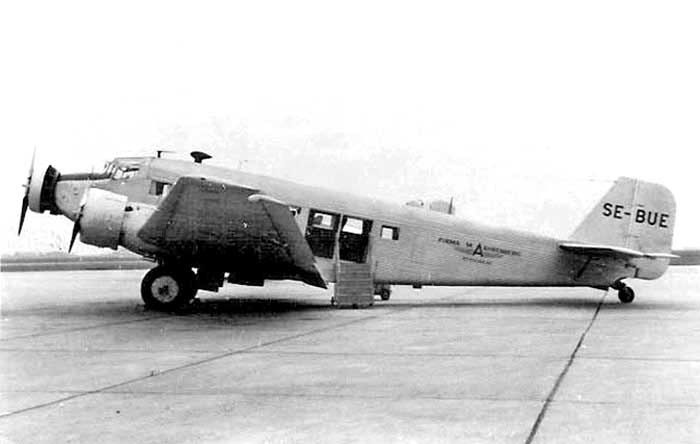

It still had the BMW radial engines with two bladed propellers. Photo by Robert Blaklie
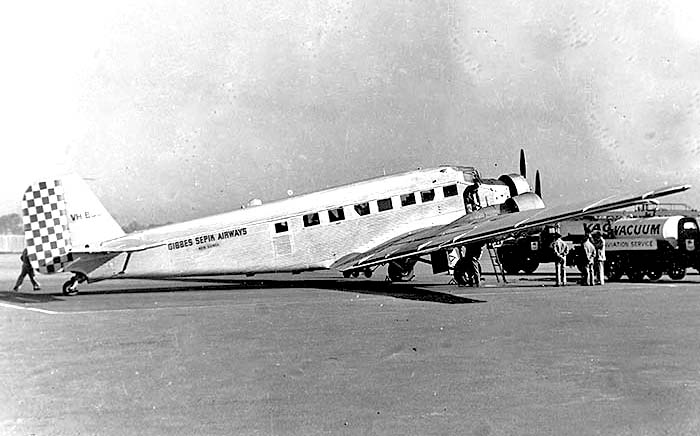
VH-BUU at Brisbane-Eagle Farm, probably during the return from Sydney to New Guinea in September 1956 after
the original BMW radials had been replaced by P&W Wasps. Geoff Goodall collection
the original BMW radials had been replaced by P&W Wasps. Geoff Goodall collection
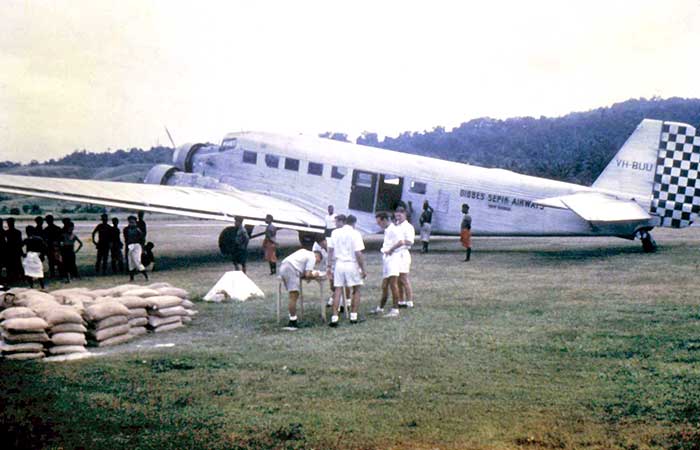
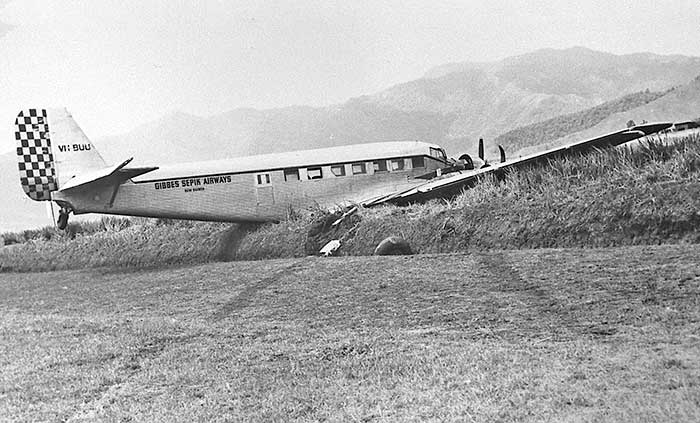
The wheel skid tracks tell the story. John Hopton Collection


| .42 | Built at Bamberg, Germany by Junkers Flugzeng Und Motorenwerke AG Luftwaffe order to military configuration, completed as model Ju 52/3mg8e |
| 28.4.42 | First flight Bamberg |
| Assigned Luftwaffe as CK+QR but not delivered | |
| .42 | Registered D-AXVA Junkers |
| .42 | Transferred to Aero OY, Helsinki, Finland Modified to civil passenger airliner by Junkers at Dessau, Germany |
| 21.8.42 | Testflown at Dessau after civil conversion. BMW 132Z-3 engines |
| 12.9.42 | Registered OH-LAO Aero O/Y, Helsinki, Finland. Fleet name Vaasa |
| 14.9.42 | Handed over to Aero O/Y |
| 21.9.42 | Arrived Helsinki on delivery |
| 31.10.42 | Leased until 6.44 to Deutsche Lufthansa |
| 31.10.42 | Registered D-AEAC Deutsche Lufthansa |
| 3.7.44 | Registered OH-LAO Aero O/Y, Helsinki, Finland |
| 18.6.46 | Minor damage at Turku on a schedueld flight |
| 12.4.49 | Final Aero service prior to retirement: Vaasa-Kemi-Vaasa, under command of Captain Juurikas |
| 4.49 | Retired and stored at Helsinki-Malmi Airport |
| 8.11.51 | sold to Firma M. Ahrenberg, Sweden |
| 1.52 | Registered SE-BUD Firma M. Ahrenberg trading as Aerotrafik, Stockholm-Bromma Airport, Sweden |
| 18.1.52 | Delivered Helsinki to Stockholm |
| 54 | Retired at Stockholm-Bromma Airport with two other Ahrenberg Ju 52s, parked in open awaiting sale |
| 4.55 | Inspected at Stockholm, by R.H. Gibbes, founder of Gibbes Sepik Airways in New Guinea. The three Junkers were advertised in good condition but on arrival he found them in poor condition with some BMW engines removed. Purchase engotiations began and Gibbes intended to send them as ship cargo. |
| 4.55 | Purchased by Gibbes Sepik Airways, Goroka, New Guinea |
| Sea freight cost proved prohibitive, so Gibbes engaged Swedish and German engineers to overhaul the three Ju 52s at Stockholm to allow them to be delivered by air to New Guinea. | |
| Following
the modification in Australia of the first Ju 52 VH-BUU to P&W Wasp
R-1340s replacing the BMW engines, DCA approved the conversion of the
other two Ju 52s in Sweden to the same Gibbes Sepik Airways
drawings. R-1340-S1H1G power plants with 3 bladed propellers and
Wirraway cowlings were shipped to Sweden. | |
| 29.8.56 | Two Ju 52s noted at Bromma, SE-AYB and the other with no markings |
| 1.57 | Overhaul completed at Stockholm with P&W Wasps installed. Painted as VH-BUV. |
| 13.1.57 | VH-BUV & VH-BUW departed Bromma on delivery. Bad weather forced a return after 2 hours. VH-BUV was under the command of GSA Captain Robin Gray |
| 14.1.57 | The pair departed again, successfully reaching Hamburg, Germany. Delivery continued via Nice, Rome, Athens, Beirut, Abadan, Bahrein, Sharjah, Karachi, Ahmedabad, Naipur, Calkcutta, Rangoon, Bangkok, Saigon, Labuan, Zamboanga, Sorong, Wewak, to Goroka |
| 8.2.57 | The pair reached Wewak, continued to home base Goroka next morning |
| 9.2.57 | Landed at Goroka after circling the town in formation, to celebrate their arrival |
| Inspection at Goroka for Australian CofA renewal | |
| 11.4.57 | Formally registered VH-BUV Gibbes Sepik Airways, Goroka, New Guinea |
| 11.4.57 | CofA renewed. |
| Entered freight service with Gibbes Sepik Airways | |
| 15.11.58 | Gibbes Sepik Airways was purchased by Mandated Airlines Ltd, Lae, New Guinea. GSA continued to operate under its own name within the MAL organisation until April 1960. |
| 15.11.58 | Port undercarriage collapsed at Mendi while turning after landing. Airframe suffered structural damage. GSA pilots Ivan Bennett and Ken Davenport. Quickly repaired on site by GSA engineers DCA accident report "Whilst turning on sloping ground the port wheel retaining bolts sheared and the axle broke at the root allowing the aircraft to fall on the port wing." (To Bobby Gibbes' relief, the documents for the sale of Gibbes Sepik Airways including its 3 Ju52s and 5 Norsemans to MAL had been signed just hours earlier, so the repair costs were MAL’s responsibility) |
| 25.8.59 | Change of Registration to VH-GSS Gibbes Sepik Airways, Goroka, New Guinea |
| 1.4.60 | Formal takeover date of Gibbes Sepik Airways by Mandated Airlines Ltd, Lae, New Guinea |
| .60 | Retired at Madang by MAL |
| 60 | Junkers VH-GSS and VH-GSW parked in the open at Madang |
| 1.9.60 | Struck-off Civil Register |
| 61 | Sold for scrap. Broken up at Madang |
| 6.62 | The scrapped airframes of
VH-GSS & VH-GSW arrived at Outer Harbour, Adelaide SA on a ship from New
Guinea, on consignment to metal merchants E. R. Way & Son, Thebarton, Adelaide. Also identified were Norseman airframe sections, salvaged Japanese wartime aircraft wrecks and at least one RAAF Bristol Beaufort |
| The Junkers fuselage sections were painted cream with green trim, "Gibbes Sepik Airways" on sides. |
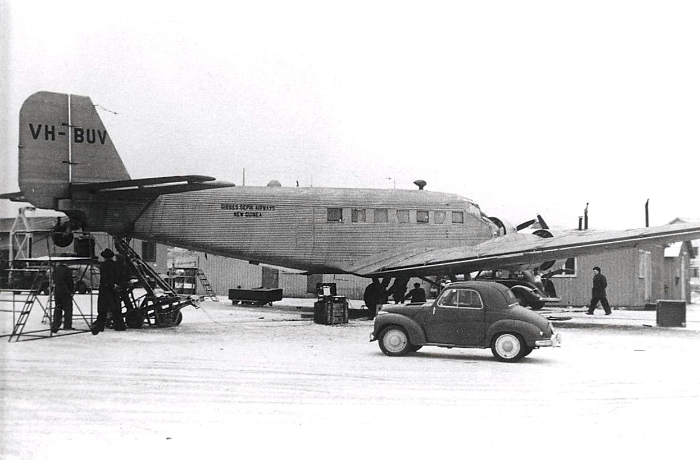
VH-BUV during its lengthy pre-delivery overhaul at Bromma, Sweden.
John Wegg collection

VH-BUV's
P&W Wasp engine installation being inspected at Bromma.
Photo by
Paul Raasch
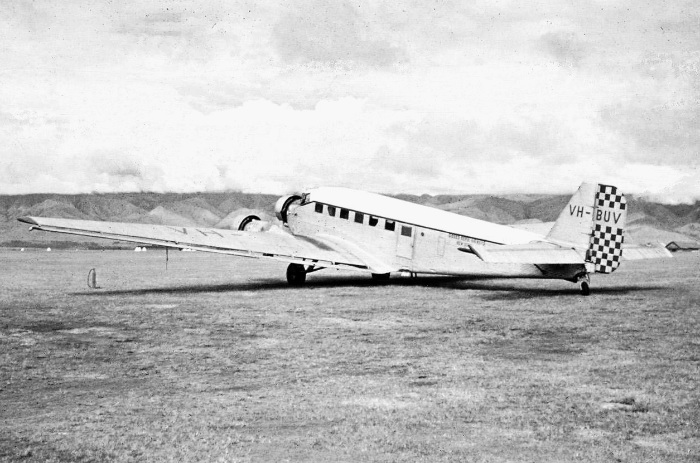
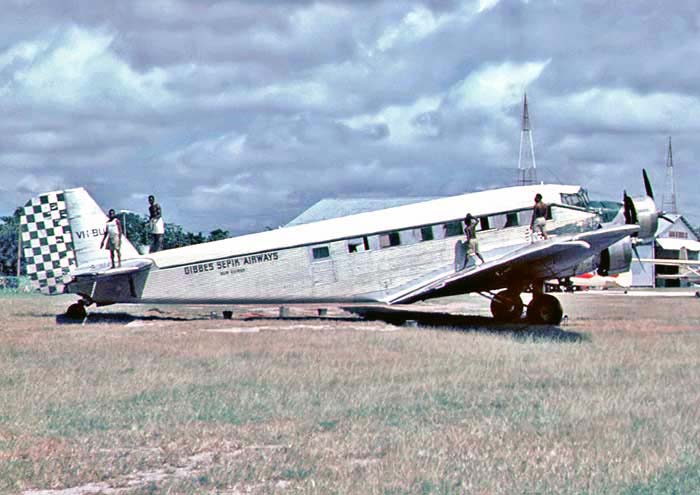
who was flying an Adastra Aerial Surveys Lockheed Hudson on a New Guinea survey at the time.
Courtesy Ron Cuskelly collection
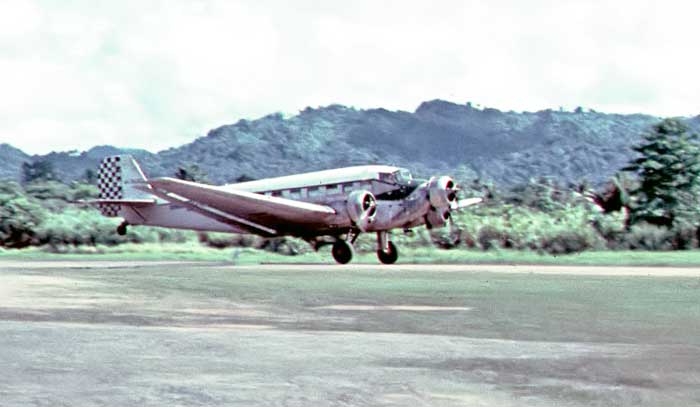


| Built at Marseilles, France by Avions AMIOT. This established French aircraft manufacturer was required under German wartime occupation to construct Ju 52s for delivery to the Luftwaffe, completed as model Ju 52/3mg14e | |
| Taken on Luftwaffe charge as 641375 code "SR+PE" | |
| Registered D-AFFF Deutsche Lufthansa | |
| Assigned as personal aircraft for Luftwaffe Field Marshall Albert Kesselring | |
| 4.45 | As
Berlin fell to invading Allied and Russian forces, this Ju 52 was flown
out of Berlin by Kesselring's pilot, who flew it to Sweden to escape
personal capture. Aircraft impounded by British forces. |
| 28.1.46 | Registered OY-DFU DDL - Det Danske Luftfartselskab A/S, Copenhagen Uffe Viking (DDL-Danish Air Lines was to merge in 1951 to form Scandinavian Airlines System-SAS) |
| 9.50 | Registered SE-AYB Firma M. Ahrenberg trading as Aerotrafik, Stockholm-Bromma Airport, Sweden |
| 54 | Retired at Stockholm-Bromma Airport with two other Ahrenberg Ju 52s, parked in open awaiting sale |
| 4.55 | Inspected at Stockholm, by R.H. Gibbes, founder of Gibbes Sepik Airways in New Guinea. The three Junkers were advertised in good condition but on arrival he found them in poor condition with some BMW engines removed. Purchase engotiations began and Gibbes intended to send them as ship cargo. |
| 4.55 | Purchased by Gibbes Sepik Airways, Goroka, New Guinea |
| Sea freight cost proved prohibitive, so Gibbes engaged Swedish and German engineers to overhaul the three Ju 52s at Stockholm to allow them to be delivered by air to New Guinea. | |
| Following the modification in Australia of the first Ju 52 VH-BUU to P&W Wasp R-1340s replacing the BMW engines, DCA approved the conversion of the other two Ju 52s in Sweden to the same Gibbes Sepik Airways drawings. R-1340-S1H1G power plants with 3 bladed propellers and Wirraway cowlings were shipped to Sweden. | |
| 29.8.56 | SE-AYB without engines noted at Bromma, parked with another Ju 52 with no markings |
| 1.57 | Overhaul completed at Stockholm with P&W Wasps installed. Painted as VH-BUW |
| 13.1.57 | VH-BUW & VH-BUV departed Bromma on delivery. Bad weather forced a return after 2 hours VH-BUW was under the command of GSA Captain Brian R. Walker |
| 14.1.57 | The pair departed again, successfully reaching Hamburg, Germany. Delivery continued via Nice, Rome, Athens, Beirut, Abadan, Bahrein, Sharjah, Karachi, Ahmedabad, Naipur, Calkcutta, Rangoon, Bangkok, Saigon, Labuan, Zamboanga, Sorong, Wewak, to Goroka |
| 8.2.57 | The pair reached Wewak, continued to home base Goroka next morning |
| 9.2.57 | Landed at Goroka after circling the town in formation, to celebrate their arrival |
| Inspection at Goroka for Australian CofA renewal | |
| 18.3.57 | Formally registered VH-BUW |
| 21.3.57 | Badly damaged at Wau when swung on takeoff and struck a building. GSA pilot Peter Manser was making a down-hill takeoff on the sloping Wau strip, carrying a heavy load of sawn timber. Just before becoming airborne the port engine suddenly lost all power, causing the aircraft to swing violently to the left and roll towards the Qantas terminal building and freight shed. The Qantas agent Mrs. Ivy Crawford saw it approaching and ran through the passenger room out on to the airfield and jumped over an embankment as the aircraft struck the building. The port wing sliced through the wooden structure, the roof collapsing as the Junkers kept rolling on to a road, tearing off its rear fuselage before Manser could bring it to a stop. The fuselage was broken into three sections and 12 feet was smashed off the port wing. DCA accident report: "Just after takeoff run was commenced, the aircraft struck a building when it ran off the strip. The accident was probably caused by a loss of power, for reasons undetermined, at a critical stage of the takeoff." QEA later took legal action against GSA for the repair costs of the Qantas building at Wau |
| The
wrecked aircraft was dismantled and loaded on two diesel semi-trailer
trucks modified for the job by a Lae transport company. Accompanied by
a team of drivers in jeeps, they moved the aircraft down the narrow
road down the mountain to Lae, and on to Goroka. | |
| 12.9.57 | Road convoy reached Goroka |
| 12 month rebuild in the Gibbes Sepik Airways hangar at Goroka under GSA engineer Paul Raasch | |
| 1.8.58 | Gibbes Sepik Airways was purchased by Mandated Airlines Ltd, Lae, New Guinea. GSA continued to operate under its own name within the MAL organisation until April 1960. |
| 30.1.59 | Testflown Goroka after rebuild |
| 1.59 | Change of Registration to VH-GSW Gibbes Sepik Airways, Goroka, New Guinea |
| 1.4.60 | Formal takeover date of Gibbes Sepik Airways by Mandated Airlines Ltd, Lae, New Guinea |
| 60 | Retired at Madang by MAL |
| 60 | Junkers VH-GSS and VH-GSW parked in the open at Madang |
| 1.9.60 | Struck-off Civil Register |
| 61 | Sold for scrap. Broken up at Madang |
| 6.62 | The scrapped airframes of
VH-GSS & VH-GSW arrived at Outer Harbour, Adelaide SA on a ship from New
Guinea, on consignment to metal merchants E. R. Way & Son, Thebarton, Adelaide. Also identified were Norseman airframe sections, salvaged Japanese wartime aircraft wrecks and at least one RAAF Bristol Beaufort |
| The Junkers fuselage sections were painted cream with green trim, "Gibbes Sepik Airways" on sides. |
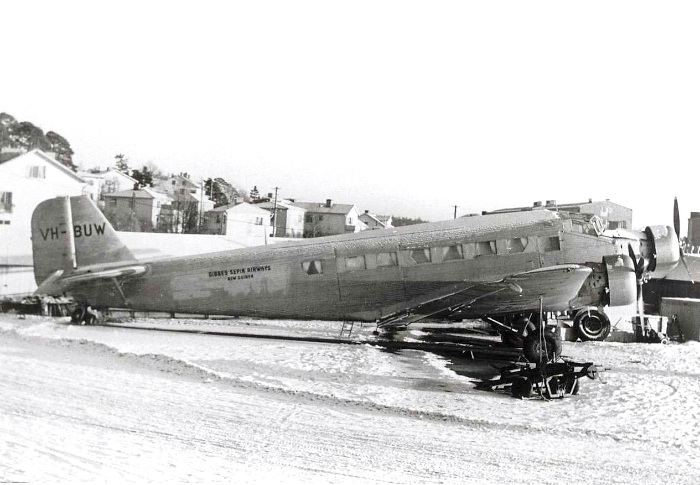
VH-BUW at Bromma, Sweden ready for delivery flight to New Guinea following installation of P&W Wasp engines.
John Wegg collection
John Wegg collection

Damage was far more than it appears - the rear fuselage, tailplane and 12 feet of port wing were torn away.
The wrecked Qantas terminal which it struck is on the left. Photo: Ben Dannecker collection


The Junkers was rebuilt and flew again. Source unknown, via Greg Thom
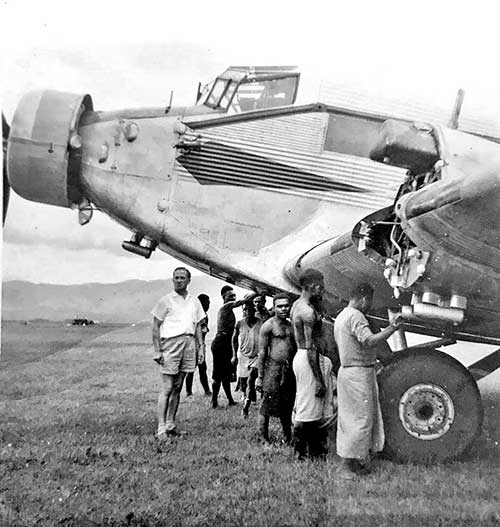


This 1960-61 view from Madang Tower shows the retired Junkers VH-GSS & GSW parked on the far side of the airfield.
Photo: Civil Aviation Historical Society
Photo: Civil Aviation Historical Society
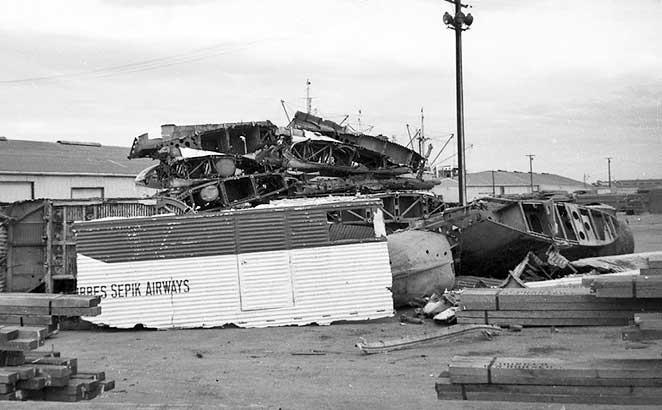
by an Adelaide metal dealer. It included Japanese wartime aircraft wrecks and Ju 52s VH-GSS & VH-GSW.
Photo by Geoff Goodall
- DCA Annual Survey of Accidents to Australian Civil Aircraft: 1957, 1959
- DCA Head Office initial registration files Ju 52s: National Archives of Australia, Melbourne
- Balus - The Aeroplane in Papua New Guinea, Volume 1, James Sinclair, Robert Brown, 1996
- Sepik Pilot - Wing Commander Bobby Gibbes, James Sinclair, Robert Brown 1977
- Your Live but Once, Bobby Gibbes, self-published 1994
- Flypast - A Record of Aviation in Australia, Neville Parnell & Trevor Boughton, AGPS 1988
- Swedish Ju 52 listing, Aviation Letter, monthly journal, November 1971
- Stockholm Report August 1956, Air Britain Digest, March-April 1957
- wrecks at Adelaide report: Aviation Historical Society of Australia Journal, June 1962
- Junkers Ju 52 production listing: www.ju52archiv.de
My thanks to Ju 52 historian David Elliston for corrected original manufacture details.